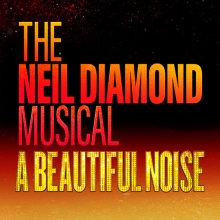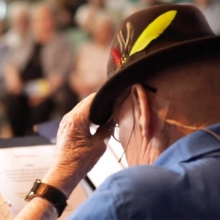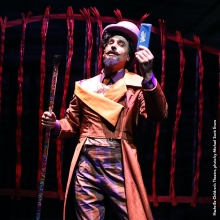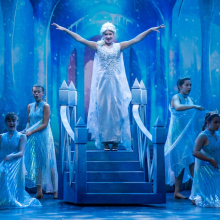Further Reading
Further Reading
Broadway Journal Interview with Jason Robert Brown
A Word From Director, Bartlett Sher
Q: What drew you to the story of The Bridges of Madison County?
A: A story that makes sense as a musical is one that must be sung- that crazy place where speaking will not suffice. This is why romance, the ineffable expression of love and loss, finds its way into music, and I think Bridges is a perfect story for music.
Q: How will the musical differ from the book and film?
A: It is really important when making a musical with sources like a book and film to somehow carefully build from the bones of a story, but to not feel that you are remaking either. This is a musical which releases through music very different things, and so we are really finding a new expression for a great story (one that belongs comfortably and uniquely in a theater). I like to think of it like Thornton Wilder’s Our Town in its simplicity and am looking for what makes this perfect for our medium.
Q: You’ve dealt with romance onstage in so much of your musical work- The Light in the Piazza, South Pacific – what makes The Bridges of Madison County unique?
A: One part of the Rodgers and Hammerstein formula was to look for source material in exotic locales- you know, beautiful places to go where a sound can be made. You feel that in South Pacific, The King and I, The Sound of Music and it is passed down to The Light in the Piazza. These are worlds that have rules and sounds that we can fall into. Bridges takes us deep into the heart of our country and the very moving situation of a beautiful young woman leaving Italy and suddenly living in Iowa, and her joyful discovery of love and painful but rewarding sacrifice. These are the deeper elements of our romance-location, contrasts and an event where something special happens in the lonely evocative landscape of Iowa- a farmhouse on the plains in the center of our country in 1965 on the brink of change and somehow the bridges- stark and beautiful- lead us into this world.
Q: How does Jason Robert Brown’s score help tell the story?
A: Where Jason is as a composer, perhaps at the height of his powers, brings such strength and humanness to the story. It has all the great heart that you find in a kind of American Puccini- with elegant and roving motifs mixed with deep American riffs and big, expressive singing- it has been thrilling to see him so in the pocket.
Q: Has Marsha Norman added any characters to the story?
A: The most important character Marsha has added is the community of Winterset, Iowa. We have neighbors, people in diners, and a backdrop that helps tell the story and provides a witness- or even a pressure to events. A sense of real community defines America- and Marsha, along with her seamless adaptation- produces an elegant open structure for Jason’s amazing music, and a social context in which the events unfold.
Q: What makes this musical relevant today?
A: Freud says that life is a struggle between freedom and responsibility. This notion, which lies beneath relationships, choices and marriages, also can be found in what we love about this musical. A story like Bridges allows us to question and maybe somehow experience things we would never do in real life and feel refreshed or renewed. Our story imagines how you can have a great love, a hard won marriage, and kids who turn out okay- and that we can make it fully through life. Musicals express these longings, and Bridges especially captures this joyfully and like you’ve never heard it before.
A Conversation With Costume Designer Catherine Zuber
Q: As your 40th Broadway show, Bridges marks quite a milestone for you. What have been some of the highlights of your career?
A: On Broadway, I have been so fortunate to have worked with many wonderful directors and projects. Some of the highlights have been South Pacific, The Light in the Piazza, Golden Boy and Awake and Sing which were created by the same team as The Bridges of Madison County.
Q: What have been some of the biggest challenges?
A: I worked on an amazing project for Lincoln Center: The Coast of Utopia. It was composed of 3 full length plays and there were hundreds of costumes, all from the 19th Century – spanning over 60 years of time.
Q: Your body of work encompasses a wide array of different time periods. Do you have a preference between creating a “period look” versus working on a project set within the present day?
A: I enjoy all time periods. Present day is actually more difficult than a project set in the past.
Q: Audience members often express how the clothes in Bridges really resonate with them because they “take them back” to their own experiences living in the 1960s. What was your research process in order to depict the time and place of Bridges in such a compelling fashion?
A: Since the location of Bridges is Iowa, we stayed away from URBAN influences in fashion. The mid ‘60s were transitional. Easing away from the silhouettes of the ‘50s and slowly introducing the details we associate with the 1960s in retrospect.
Q: How do you start a project? What’s the first thing you typically do when you take on a new show?
A: When I start a new project, the first thing I do is read and make notes on the script. I then re-read the script and break it down into the moments where the characters might need to change their look. I meet with the director to go over his vision of the characters and how they relate to each other. I do a lot of research on the world of the play and the specifics of each character. I sketch a design for every moment that each character will need in the play. I meet with the other designers to coordinate our visual choices and work on color. I start to assemble the fabrics for any of the costumes that we will make, and assemble any costumes that will be sourced. Then it is on to the accessories and meetings with the wig designer. I then meet with the costume builders and discuss the research, proportions and details of the costumes. This is all before first rehearsal and fittings with the actors.
A Conversation With The Director And Authors
Q: Why make a musical out of The Bridges of Madison County?
Marsha Norman: It has something in it that is very powerful that people respond to. That is the kind of opportunity that you want for adaptation. People would like a different experience of something that they already love. And those are the kind of things that I like working on: The Color Purple, The Secret Garden, and now Bridges.
Q: In the stage adaptation, the community of Iowa becomes, in essence, a character in the story. How do you reflect that on stage?
Bartlett Sher: When you are lucky enough to have someone like Marsha Norman give you a script it gives you all sorts of challenges like location, space, where to go from here to there. But the thing that was very clear in it, and that we both discussed, was to activate the community into a witness, bystander, potential conflict and, in some ways, transformative element in the piece. So you have songs like “You’re Never Alone” and ‘To Build A Home” which are about the community. And one of the things that is intriguing is the contrast between Robert Kincaid, who lives a solitary life, and a woman like Francesca Johnson, who lives within the community.
Jason Robert Brown: In the months before I started writing The Bridges of Madison County, I wanted more than anything to write something full of what I call “big music”: long, soaring lines; huge dynamic range; large structures with a lot of emotional waves. The novel immediately suggested all of that and more – there is such passion in Waller’s writing, such yearning, and even more importantly, so much left unsaid. The lyric theatre felt like the perfect vehicle to tell the story of Robert and Francesca.
Q: Why have you chosen to make the characters of “Robert” and “Francesca” younger?
JRB: The poignancy of Francesca’s choice is that we believe it could have gone either way. Marsha and I felt that we would make it even more powerful if Francesca were still young enough to see the possibility of starting a new life with Robert. That said, I think the show could be cast quite successfully with older actors, and I hope it will be in the years to come!
Q: In “Another Life,” you have Robert Kincaid’s ex-wife singing a song, while simultaneously across the stage Francesca and Robert are falling in love over a shared dinner. Tell us about this on stage blending of the past and present.
BS: “Another Life” was one of the first songs that Jason wrote for the musical and it is very striking because it is from an unexpected character, which is the ex-wife of Robert Kincaid. And it comes right at the point when the two people are having their first dinner together. So it offered a dramatic opportunity to blend two theatrical moments into one. And I think for me what helps make a musical special is looking for those opportunities where something you are not used to seeing happens. So the unfolding of his past, of his ex-wife talking about the troubled history in their past while he is discovering a new love brings out both the idea of another life and the beginning of another life between he and Francesca.
MN: Also, “Another Life” states in a very oblique way one of the big themes of the show. That there is always, at any moment, this big question that we have about, “What if I were living that other life?”
Q: In working with Michael Yeargan to design the look for the show, how did the bridge itself figure into your plans?
B: The biggest challenge in the world was, how do you put a bridge on a Broadway stage? And the even greater challenge is that it is a covered bridge. It is one thing to have bridges that are open, where you can see people on it, but it’s another to have a covered bridge where you can go in only to disappear. The origin of our design came from a film by Lars von Trier called Dogville which was all set inside a large sound studio and it had at one end a kind of frame. We aren’t even sure quite what it was. But that led to us doing the open frames that fences could be attached to. So when you watch Robert Kincaid work you can see all the way through, and you can imagine the rest. So the design suggests a bridge, and the audience fills in the rest in their minds.
Marsha Norman On The Bridges of Madison County
You cannot make a musical out of just anything. When I’m teaching musical book, I often say that a musical is a love story with a great final scene. But you also need a property that “sings,” a story whose characters feel things they cannot say, and thus must sing them. And it has to take place in an exotic location, in our case, Iowa, and then all you need are gorgeous stars, collaborators you can trust, millions of dollars, and a great title.
The Bridges of Madison County, the novel, sold 60 million copies starting in 1992 and wasn’t replaced as America’s favorite novel until The DaVinci Code came out 11 years later. There was also a movie version that featured Clint Eastwood and Meryl Streep as the passionate lovers. So clearly, there is something in the story that people respond to. But you don’t choose a popular title because it will sell tickets. You choose it because its popularity means it’s one of the old stories somehow, one of the stories we need to hear again and again.
But I was drawn to this material as a human being, not just as a writer. By 1965, when the musical takes place, women across the country were beginning to come out of the kitchen and take an active role in their communities. Women’s voices began to be heard on the radio; Joan Baez, Joni Mitchell, Odetta, Aretha Franklin, and Patsy Cline. Women began joining war protest movements, as they had during the Civil Rights movement, and as they would again in the Women’s movement. Francesca’s growing awareness of her isolation in her house, and her ability to express this to her husband is hard for her, culturally and personally. What she doesn’t know is that she is joining the chorus that will make a different life possible for all the generations of women who come after her, including me.
“Robert Kincaid - Before Iowa" By Robert James Waller
Before Iowa, before the covered bridges, before Francesca, there was the road . . . always the road, a man following his boyhood dreams. There were the thrum of ship engines north of Cairo and the glide of Arab dhows, the chug of old boats up the Amazon. There were steaming trains that left from winter stations on the steppes of Russia or those of Asia where he sometimes rode on the carriage roofs, watching the countryside rolling by, rattling over rickety bridges with rivers far below. There were DC-3s and DC-47s that took him over the Burma Hump to China or to Pacific battlefields. There were camels in the Sahara, an Indian motorcycle, and a truck named Harry. Robert Kincaid went out there, while others stayed at home by their yellow evening lamps.
He was a solitary figure, a man alone but not lonely, who went anywhere a journalistic assignment or his military orders took him. His work was company enough for him most of the time, quite enough when you are the keeper of a grand romantic sense of adventure, emanating from somewhere in his genes and greatly influencing his photography and the singular man he was. Who knows the provenance, the source of this grand vision, but it was there, and it was called the road.
Women? Not many, not much expertise there. He was no slouching lothario drumming up ladies for an evening’s entertainment, no expert in the erotic arts. In fact, he was slightly clumsy around women, simply through limited experience. Having once been married for a short time, Robert Kincaid assumed he would live out his days alone, was sure of it. And then he came to Iowa, to the bridges of Madison County, and to Francesca Johnson, who lived near the banks of Middle River.




